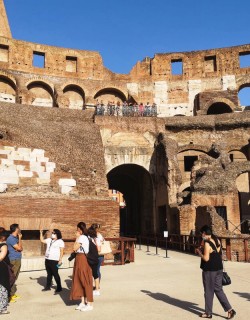If you’re looking for peace, quiet, beauty and history in Rome, look no further than the Protestant Cemetery. The moment you pass the pyramid and enter the cemetery gates, you leave the noise of the city far behind, and enter another world.
The Protestant Cemetery (also known as the Cimitero Acattolico) is a highlight of our Hidden Beauty of Rome private tour, which focuses on peaceful, underrated sites in the Eternal City. Although the cemetery is not as famous as other attractions in Rome, it’s a place that has been enchanting visitors for centuries.
Technically, the oldest tomb pre-dates the Colosseum. The Pyramid of Gaius Cestius was built around 18 BC, as the tomb for a wealthy Roman nobleman. But the first real burial in the cemetery was in 1738 - a young Oxford student who died after falling from a horse. Although the area was not an official cemetery, but rather a field on the edge of the city walls, it soon became a popular burial place for non-Catholic foreigners who died in Rome.
The most famous tombs belong to the English Romantic poets John Keats and Percy Bysshe Shelley. Keats died from tuberculosis at the age of only 25. He was buried in an unnamed grave in the old section of the cemetery; his tomb reads “Here lies one whose name was writ in water”. Beside him is the grave of Joseph Severn, a friend of Keats who nursed him as he was dying. The small grave in the middle is for Severn’s infant son, who died in a tragic accident.
The cemetery is full of tragic lives, and untimely deaths. Shelley’s son is also buried here - he died from malaria at the age of three. Yet despite the tragedy, Shelley saw the beauty in the cemetery. When he visited, he commented that “It might make one in love with death, to think that one should be buried in so sweet a place”. Shelley was later buried in the cemetery himself, in the newer section on the hill, after drowning at the age of 29.
Many assume that cemeteries are depressing places, yet the beauty of the Protestant Cemetery is that it’s a remarkably serene, peaceful place. Walking among the tombs and the cypress trees on a warm spring morning, it’s a place that inspires and uplifts. As you explore the cemetery with your guide, learning about the extraordinary people who are buried here - poets, painters and politicians - the focus will be on their lives, rather than their deaths. Rome has always attracted an interesting mix of people from all over the world, and the cemetery is a testament to the city’s cosmopolitan character. As well as the many English tombs, there are tombstones inscribed in Arabic, Hebrew and cyrillic.
The newer part of the cemetery on the hill is home to some striking tombs, such as the famous “Angel of Grief” - a sculptor’s touching tribute to his wife - and the portrait of the fabulously named Devereux Plantagenet Cockburn, who reclines on his tomb with a book in his hand and his spaniel by his side. This picturesque section of the cemetery is densely packed with trees and tombs, and it can be easy to miss some of the most interesting graves. Go with a guide and you’ll not only get to see the highlights of the cemetery, but you’ll also learn the secrets and stories behind the tombstones.
To discover the timeless beauty of the Protestant Cemetery and find out why it continues to enchant and inspire its visitors, join our private tour of Rome.
~Alexandra Turney~


